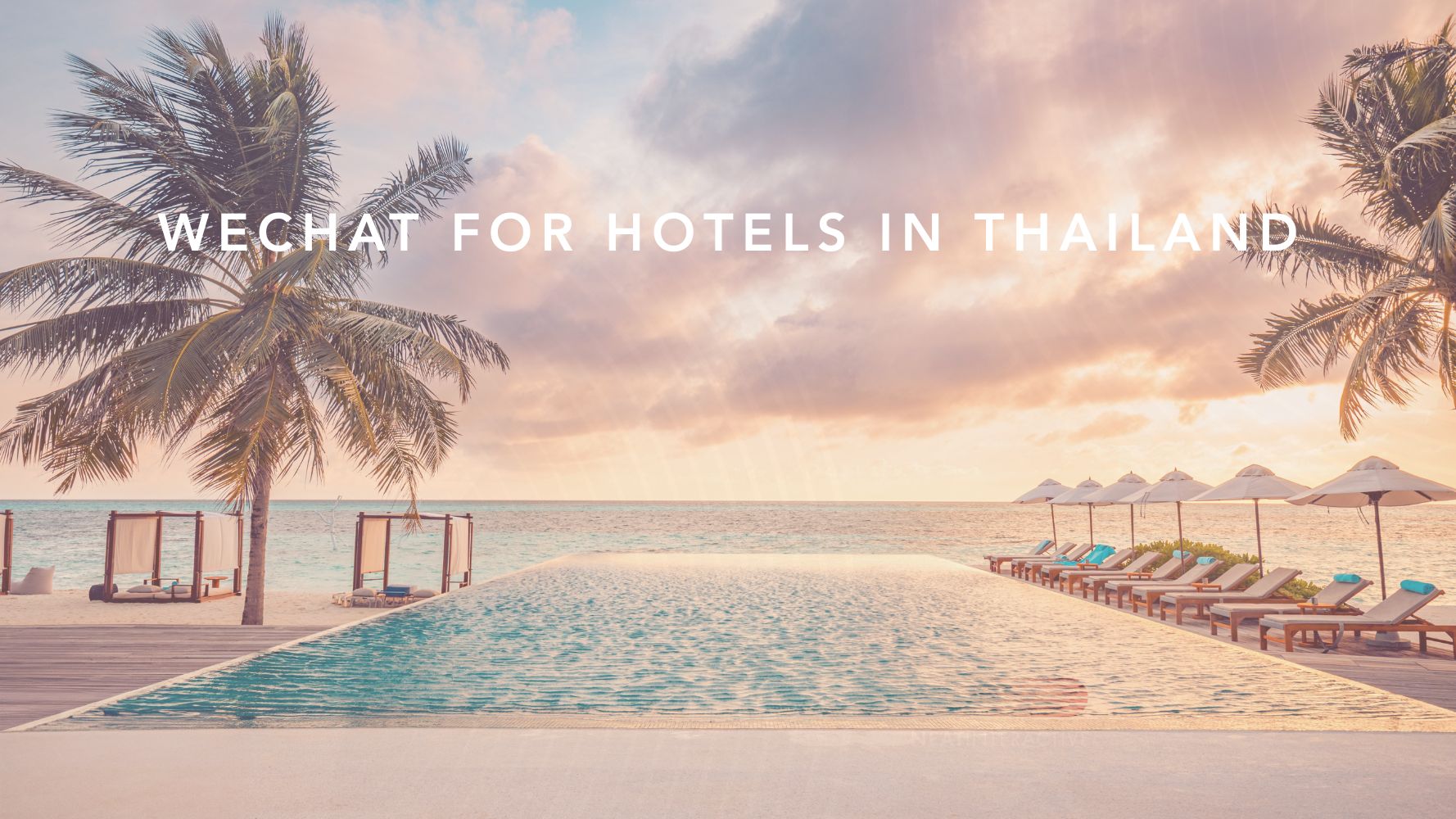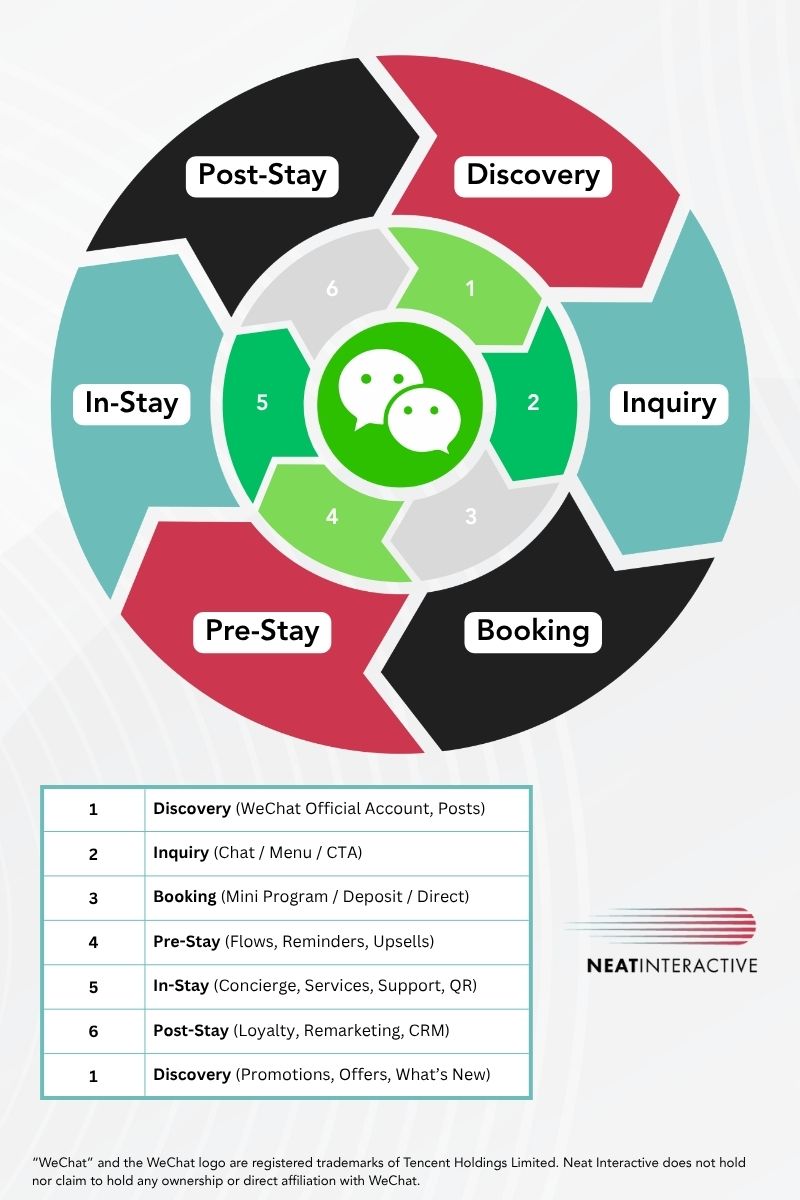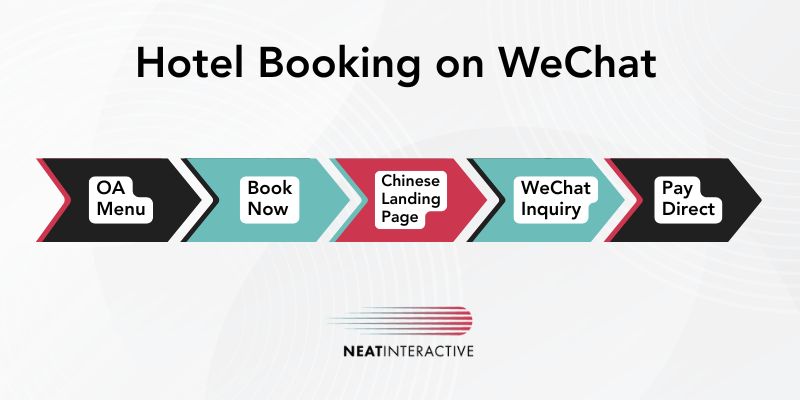WeChat for Hotels in Thailand — From Discovery to Direct Bookings and Post-Stay Loyalty
How hotels in Thailand can use WeChat to get discovered by Chinese travelers, drive direct bookings, streamline guest communication, and maintain loyalty after the stay.

Despite falling numbers recently, China remains one of Thailand’s most important inbound markets, and WeChat sits at the center of how Chinese travelers discover, evaluate, book, and interact with hotels. For hospitality, WeChat is not merely “another social channel”—it’s a guest-journey system that can replace email, brochures, QR microsites, web forms, and even parts of your booking process and concierge duties.
This guide shows how hotels in Thailand can use WeChat to:
- Get discovered before the trip
- Convert inquiries into bookings
- Deliver frictionless service during the stay
- Build loyalty and repeats post-stay
We focus on hotel-specific use, not generic “WeChat marketing.”
WeChat’s Role in the Hotel Guest Journey
WeChat is an essential part of Chinese travel planning because it:
- Centralizes the journey — search, content, messaging, payments, and service in one place
- Removes friction — no app switching, no email threads, fewer long forms
- Builds trust — guests feel safer communicating and paying inside WeChat
Closed-loop funnel:
 Compared to Western funnels (IG/FB → website → email → form → WhatsApp), WeChat keeps the user in one ecosystem. This is ideal for reducing drop-off and speed-running decisions.
Compared to Western funnels (IG/FB → website → email → form → WhatsApp), WeChat keeps the user in one ecosystem. This is ideal for reducing drop-off and speed-running decisions.
The WeChat Stack for Hotels
| WeChat Feature | What it Does for Hotels |
|---|---|
| Official Account (OA) | Searchable brand hub, articles, and structured service menus |
| Mini Programs (MP) | Booking, concierge, service requests, loyalty utilities |
| Tagging & CRM | Segmentation by intent, journey stage, and property |
| WeChat Pay & QR | Deposits, add-ons, in-stay payments, scannable journeys |
These are your building blocks. Below, we map them to each stage of the hotel guest journey.
Stage 1: Discovery — Be Findable Before the Trip
Goal: Get found inside WeChat before a traveler ever lands on your website.
Tactics
-
Official Account (Service Account) with:
- Chinese bio emphasizing destination + category (e.g., luxury beachfront resort in Phuket)
- Menu making it easy to find what you want travelers to see (e.g., Views, Rooms, Restaurants, Swimming Pools, Gyms, Kid's Club)
- Links to Xiaohongshu (Red Book) and Douyin for social proof
- Primary CTA to your WeChat menu (not a generic homepage)
-
Searchable Articles that rank inside WeChat:
- “Rooms & Suites: Ocean-View Guide”
- “Top 5 Phuket Day Trips Near [Hotel]”
- “Dining at [Hotel]: Chinese-Friendly Options and Hours”
-
QR Surfaces (digital): add QR links from Weibo/Douyin posts to pull users into your OA
Related reading: strengthen discovery on social: Chinese Social Media.
Stage 2: Inquiry — Reduce Friction Pre-Booking
Once a traveler follows your OA, they evaluate you through menus, articles, and mini-site style pages. Your OA menu should act like a simplified Chinese website:
Recommended Menu Structure
- Rooms & Offers → “Book” or “Inquire” flow
- Dining / Spa / Experiences → proof and photos; link to service requests
- Location & Transport → airport transfer, maps, FAQs
- FAQ (CN) → payment, deposit, kids policy, language, WeChat Pay
- Concierge → live chat and “request a call back”
WeChat Articles should support the menu, not compete with it. Use them to answer deep questions (seasonality, family tips, nearby attractions) and interlink back to menu items.
Conversion booster: pair the menu with Chinese landing pages optimized for speed, clarity, and trust: Website for China.
Stage 3: Booking — From Intent to Payment
You can close bookings in three ways:
- Mini Program Booking Engine (best UX; more build effort)
- WeChat Pay Deposit Flow (fast path for direct confirmation)
- Inquiry-to-Booking Chat (lowest lift; good for boutique/luxury)
Fastest, low-lift path to revenue:
 Automations to wire on day one
Automations to wire on day one
- Auto-reply on “book”, “price”, “room”, “套餐/促销”: provide offer link + agent handoff
- Tags on profile:
Intent=Booking,Market=CN,Property=Bangkok - 48-hour follow-up: “Still deciding? Here are dates with availability and a dining credit.”
Traffic acceleration: route WeChat ads and social traffic into this flow: Online Ads in China.
Stage 4: Pre-Stay — Operational Messaging That Scales
Pre-arrival questions are predictable. Automate 60–80% of them with:
- Keyword triggers (“airport”, “早餐”, “加床”) → instant answers + concierge handoff
- Timed reminders 72/48/24 hours pre-arrival (transfer, check-in, weather, dress code)
- Upsell prompts tied to stay dates (spa, dining, experiences)
Example Pre-Stay Pack
- Airport pickup confirmation + driver details
- Early check-in / late check-out options
- Weather + packing tips for the week
- On-property QR: “Scan to chat with concierge in Chinese”
This relieves your front office while lifting guest satisfaction.
Stage 5: In-Stay — Concierge, Upsells, and Service Requests
WeChat can function as a digital concierge desk:
Common Flows
- Room Service: menu → choose items → confirm in chat → send to POS
- Spa Booking: date/time selector → confirmation → reminder
- Housekeeping/Engineering: “Report an issue” → ticket to staff system
- Wayfinding/Experiences: map links, pickup points, event schedules
Benefits
- Guests type in Chinese, not call in English
- Faster responses and closed loops (fewer missed calls)
- Higher capture on ancillary revenue (spa/F&B/experiences)
- Better reviews (silent issues surface fast)
Stage 6: Post-Stay — Loyalty and Repeat Demand
After checkout, WeChat becomes your owned audience channel (vs OTA-owned):
- Thank-you plus photo gallery link
- Loyalty hooks (stay again offers, dining credits, birthday/special-day triggers)
- Satisfaction survey inside WeChat
- Geofenced or seasonal re-engagement (National Holidays, Golden Week)
Segmentation ideas
Stayed=Yes+RoomType=Suite+Kids=Yes→ family packages next tripStayed=Yes+City=Bangkok→ new rooftop dining launch inviteInquired Only→ nurture flow with RED/Douyin content
What Hotels Commonly Get Wrong
| Mistake | Why It Hurts |
|---|---|
| Treating the OA like a brochure | It must be a funnel with menus, flows, and CTAs |
| Linking only to English pages | Conversion collapses; guests bounce |
| No tags or segmentation | You can’t personalize or remarket |
| No cross-signals from social | Discovery weak; trust not earned |
| No pre-stay automations | Ops team overloaded, slow replies, lost upsells |
Quick Implementation Blueprint (Thailand Hotels)
Month 1 (Foundations)
- Register Service Account, finalize CN brand and keywords
- Build menu (Rooms/Offers, Dining/Spa, Transport, FAQ, Concierge)
- Publish 3–5 articles aligned to search intent
- Launch 2 Chinese landing pages (one room, one offer)
Month 2 (Flows + Tracking)
- Wire auto-replies, keyword triggers, tags
- Set 48-hour follow-up for booking intent
- Add pre-stay pack (transfer, check-in, upsells)
- Place QRs at key touchpoints (website CN pages, social bios, PDFs)
Monthly (Growth Sprints)
- Red Book/Douyin content + seeding; interlink to OA and CN pages
- Add one new flow (e.g., spa, issue reporting, loyalty)
- Report on: saves (Red Book), reach (Douyin), inquiries (WeChat), bookings, upsells
This aligns with our full China playbook: Chinese Marketing.
Practical Data Model (Tagging & Events)
Use a simple, portable structure first:
Profile Tags
Market=CNIntent=Booking / Info / PostStayProperty=Bangkok / Phuket / SamuiJourneyStage=PreStay / InStay / PostStayInterest=Dining / Spa / Family / Romance / Meetings
Events to Track
MenuClick,ArticleRead,InquiryStart,DepositPaid,SpaBooked,IssueReported,SurveyCompleted
Export tag + event summaries monthly and map to GA4 or your BI tool.
Conclusion
For Thailand hotels targeting Chinese guests, WeChat is the highest-leverage platform across the entire guest lifecycle. It compresses friction from discovery to booking, scales pre- and in-stay service, and preserves post-stay relationships that OTAs can’t. Start lean (OA + menus + CN landing pages + basic automations), then layer mini-programs, payments, and deeper CRM over time.
- Strengthen discovery with Red Book/Douyin: Chinese Social Media
- Ensure conversion with Chinese landing pages: Website for China
- See the full playbook: Chinese Marketing
FAQ
What type of WeChat account should hotels use?
A Service Account (not Subscription) for better visibility and features suited to service workflows.
Do we need a Mini Program to start generating bookings?
No. Many hotels start with OA + menus + CN landing pages + WeChat Pay and upgrade later.
Can WeChat integrate with PMS/CRM?
Yes—begin with tags + exports. Add API-based sync for loyalty and advanced segmentation when needed.
How do we measure success?
Track: Red Book saves, Douyin reach, OA menu clicks, inquiries, deposits/bookings, and in-stay upsells. Optimize monthly.
Is this only for luxury?
No. Boutique and city hotels see strong ROI when flows are clear and landing pages are localized.
